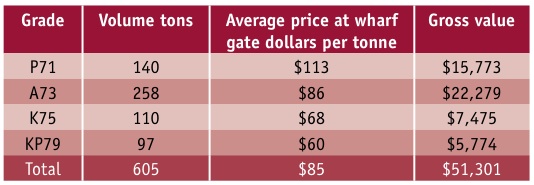Poplar logging case study
Peter Davies-Colley, New Zealand Tree Grower February 2008.
Ngarakau is a 300 hectare dry stock farm located at Titoki in Northland. It was formerly owned by Richard and Wilma Davies-Colley and is now owned by Peter and Nikki Davies-Colley. The contour is rolling but the clay soils are highly erosion prone. Tunnel gullying or tomos are prevalent and mass earth movement is also common.
Soil erosion prevented
Poplars have been planted for soil conservation on Ngarakau since 1966. Around 3,000 Italian hybrid poplar poles were planted in the period up to 1976 until leaf rusts arriving from Australia prevented further plantings of these hybrids. Most of the poplars were space planted as three metre cattle poles. The end result has been a property covered in beautiful deciduous shade trees and soil erosion brought to a virtual stop.
While erosion control was the primary reason for planting, Richard always had an interest in trees for all reasons and began pruning the poplars to enhance timber production. Pruning became more serious during dry summers to provide supplementary feed for cattle. This has been reported in past Tree Grower articles.
In the past there was little enthusiasm in New Zealand for using poplar as timber. Internationally it is recognised as a useful timber used in a diverse range of products from clogs to chopsticks. Neil Barr told me a number of times that it was essential for parts that wear in horse drawn grain harvesters although the demand for this purpose has declined of late. Many farm foresters have experimented with poplar timber over the years with a standard use being wooden truck decks. We have milled poplars and used the timber successfully for kitchen cabinets.
Logging the poplars
Since 2003 our harvest management business has been exporting a significant volume of radiata logs through Pacific Forest Products Ltd. Some of Pacific Forest Products Asian sawmill clients started asking for poplar logs and have built good demand for poplar logs. The prices for all export logs increased significantly through 2006 so we decided to start logging some poplars on Ngarakau in November 2006.
The first trees to log were the original farm stool bed nursery which had been converted to a plantation when pole cutting stopped. The rest of the trees were wide spaced trees growing in the gullies. Peter and Nikki’s son Simon led the two-man logging crew. This inter-generational aspect added extra value to a typical farm forestry project.
Each day 10 to 20 trees would be felled and a mob of young Friesian bulls would graze the leaves. The following day these trees would be limbed which would give the bulls access to any leaves previously out of reach. Once all the leaves were eaten the trees were shovel logged with a tracked log loader, cut into logs and loaded on to a forwarder for extraction to a roadside landing.
From here they were loaded on to a road truck and transported to Marsden Point Port for export. Once the felling, grazing, limbing and log-making rotation was underway it was relatively easy to keep the small crew productive. The most disruptive aspect was the damage that 20-ton log loaders do to gate strainers as they move from paddock to paddock.
Cutting and income
The cutting strategy was very simple with four grades. A pruned grade, P (71) was cut with a minimum small end diameter of 40 cm and a maximum of three branches per log. This branch limit was necessary to cope with the water shoot branches that can be a problem with pruned poplars. A large unpruned sawlog was cut with a minimum small end diameter of 30cm - A (73). A small sawlog was cut with a minimum small end diameter of 20cm, K (75). A pulp log was cut with a minimum SED of 14cm - KP (79). It was decided not to cut a chip log for transport to the central North Island pulp mills due to the high cartage cost.

Logging and cartage costs were around $45 a tonne. The areas logged were relatively easy but did not have logging truck access making the forwarder the logical option. All the areas have been replanted with Kawa poles. Kawa is the rust resistant clone that we have been planting since around 1990. It performs well on our sites, and growth and form is significantly better than the Italian hybrids that it is replacing. It is expected that the Kawa will be established in time to carry on the soil holding function as the harvested poplar’s roots start to decay.
The aim is to repeat this operation every second summer depending on log prices. There are enough poplars on Ngarakau to allow this process to continue virtually indefinitely.
Erosion control and financial success
These poplars were planted for erosion control and have been spectacularly successful at this. They have fed stock in droughts and offered shade against the Northland summer sun and shelter from wind. Their deciduous habit and wide spacing has allowed continuous grazing without any significant effect on pasture production. They have now been logged for satisfactory financial returns. Perhaps poplar might be a candidate for agri-forestry.

 Farm Forestry New Zealand
Farm Forestry New Zealand